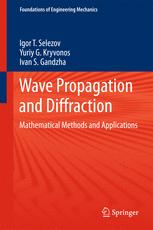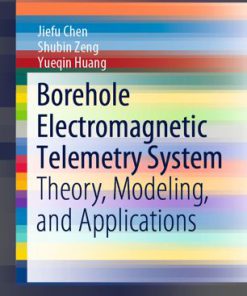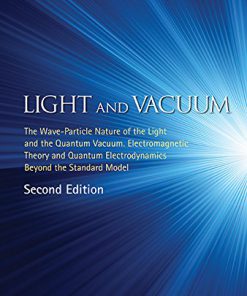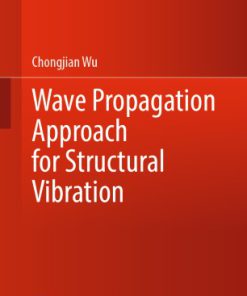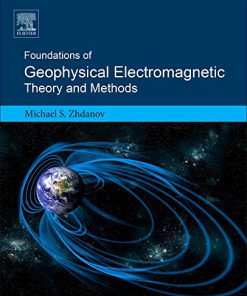Electromagnetic Wave Propagation Radiation and Scattering From Fundamentals to Applications IEEE Press Series on Electromagnetic Wave Theory 2nd Edition by Akira Ishimaru 1119079538 9781119079538
$50.00 Original price was: $50.00.$25.00Current price is: $25.00.
Electromagnetic Wave Propagation Radiation and Scattering From Fundamentals to Applications IEEE Press Series on Electromagnetic Wave Theory 2nd Edition by Akira Ishimaru – Ebook PDF Instant Download/DeliveryISBN: 1119079538, 9781119079538
Full download Electromagnetic Wave Propagation Radiation and Scattering From Fundamentals to Applications IEEE Press Series on Electromagnetic Wave Theory 2nd Edition after payment.
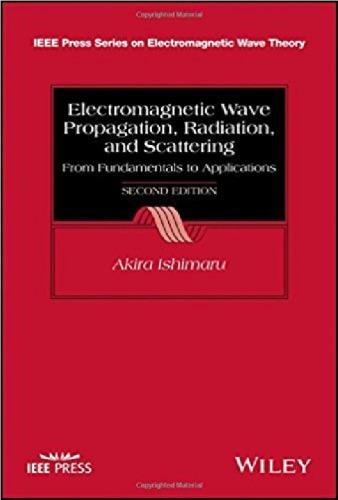
Product details:
ISBN-10 : 1119079538
ISBN-13 : 9781119079538
Author: Akira Ishimaru
One of the most methodical treatments of electromagnetic wave propagation, radiation, and scattering–including new applications and ideas
Presented in two parts, this book takes an analytical approach on the subject and emphasizes new ideas and applications used today. Part one covers fundamentals of electromagnetic wave propagation, radiation, and scattering. It provides ample end-of-chapter problems and offers a 90-page solution manual to help readers check and comprehend their work. The second part of the book explores up-to-date applications of electromagnetic waves–including radiometry, geophysical remote sensing and imaging, and biomedical and signal processing applications.
Electromagnetic Wave Propagation Radiation and Scattering From Fundamentals to Applications IEEE Press Series on Electromagnetic Wave Theory 2nd table of contents:
Part I Fundamentals
Chapter 1 Introduction
Chapter 2 Fundamental Field Equations
2.1 Maxwell’s Equations
2.2 Time-Harmonic Case
2.3 Constitutive Relations
2.4 Boundary Conditions
2.5 Energy Relations and Poynting’s Theorem
2.6 Vector and Scalar Potentials
2.7 Electric Hertz Vector
2.8 Duality Principle and Symmetry of Maxwell’s Equations
2.9 Magnetic Hertz Vector
2.10 Uniqueness Theorem
2.11 Reciprocity Theorem
2.12 Acoustic Waves
Problems
Chapter 3 Waves in Inhomogeneous and Layered Media
3.1 Wave Equation for a Time-Harmonic Case
3.2 Time-Harmonic Plane-Wave Propagation in Homogeneous Media
3.3 Polarization
3.4 Plane-Wave Incidence on a Plane Boundary: Perpendicular Polarization (s Polarization)
3.5 Electric Field Parallel to a Plane of Incidence: Parallel Polarization (p Polarization)
3.6 Fresnel Formula, Brewster’s Angle, and Total Reflection
3.7 Waves in Layered Media
3.8 Acoustic Reflection and Transmission from a Boundary
3.9 Complex Waves
3.10 Trapped Surface Wave (Slow Wave) and Leaky Wave
3.11 Surface Waves Along a Dielectric Slab
3.12 Zenneck Waves and Plasmons
3.13 Waves in Inhomogeneous Media
3.14 WKB Method
3.15 Bremmer Series
3.16 WKB Solution for the Turning Point
3.17 Trapped Surface-Wave Modes in an Inhomogeneous Slab
3.18 Medium With Prescribed Profile
Problems
Chapter 4 Waveguides and Cavities
4.1 Uniform Electromagnetic Waveguides
4.2 TM Modes or E Modes
4.3 TE Modes or H Modes
4.4 Eigenfunctions and Eigenvalues
4.5 General Properties of eigenfunctions for Closed Regions
4.6 k–β Diagram and Phase and Group Velocities
4.7 Rectangular Waveguides
4.8 Cylindrical Waveguides
4.9 TEM Modes
4.10 Dispersion of a Pulse in a Waveguide
4.11 Step-Index Optical Fibers
4.12 Dispersion of Graded-Index Fibers
4.13 Radial and Azimuthal Waveguides
4.14 Cavity Resonators
4.15 Waves in Spherical Structures
4.16 Spherical Waveguides and Cavities
Problems
Chapter 5 Green’s Functions
5.1 Electric and Magnetic Dipoles in Homogeneous Media
5.2 Electromagnetic Fields Excited by an Electric Dipole in a Homogeneous Medium
5.3 Electromagnetic Fields Excited by a Magnetic Dipole in a Homogeneous Medium
5.4 Scalar Green’s Function for Closed Regions and Expansion of Green’s Function in a Series of Eigenfunctions
5.5 Green’s Function in Terms of Solutions of the Homogeneous Equation
5.6 Fourier Transform Method
5.7 Excitation of a Rectangular Waveguide
5.8 Excitation of a Conducting Cylinder
5.9 Excitation of a Conducting Sphere
Problems
Chapter 6 Radiation from Apertures and Beam Waves
6.1 Huygens’ Principle and Extinction Theorem
6.2 Fields Due to the Surface Field Distribution
6.3 Kirchhoff Approximation
6.4 Fresnel and Fraunhofer Diffraction
6.5 Fourier Transform (Spectral) Representation
6.6 Beam Waves
6.7 Goos–Hanchen Effect
6.8 Higher-Order Beam-Wave Modes
6.9 Vector Green’s Theorem, Stratton–CHU Formula, and Franz Formula
6.10 Equivalence Theorem
6.11 Kirchhoff Approximation for Electromagnetic Waves
Problems
Chapter 7 Periodic Structures and Coupled-Mode Theory
7.1 Floquet’s Theorem
7.2 Guided Waves Along Periodic Structures
7.3 Periodic Layers
7.4 Plane Wave Incidence on a Periodic Structure
7.5 Scattering from Periodic Surfaces Based on the Rayleigh Hypothesis
7.6 Coupled-Mode Theory
Problems
Chapter 8 Dispersion and Anisotropic Media
8.1 Dielectric Material and Polarizability
8.2 Dispersion of Dielectric Material
8.3 Dispersion of Conductor and Isotropic Plasma
8.4 Debye Relaxation Equation and Dielectric Constant of Water
8.5 Interfacial Polarization
8.6 Mixing Formula
8.7 Dielectric Constant and Permeability for Anisotropic Media
8.8 Magnetoionic Theory for Anisotropic Plasma
8.9 Plane-Wave Propagation in Anisotropic Media
8.10 Plane-Wave Propagation in Magnetoplasma
8.11 Propagation Along the DC Magnetic Field
8.12 Faraday Rotation
8.13 Propagation Perpendicular to the DC Magnetic Field
8.14 The Height of the Ionosphere
8.15 Group Velocity in Anisotropic Medium
8.16 Warm Plasma
8.17 Wave Equations for Warm Plasma
8.18 Ferrite and the Derivation of its Permeability Tensor
8.19 Plane-Wave Propagation in Ferrite
8.20 Microwave Devices Using Ferrites
8.21 Lorentz Reciprocity Theorem for Anisotropic Media
8.22 Bi-Anisotropic Media and Chiral Media
8.23 Superconductors, London Equation, and the Meissner Effects
8.24 Two-Fluid Model of Superconductors at High Frequencies
Problems
Chapter 9 Antennas, Apertures, and Arrays
9.1 Antenna Fundamentals
9.2 Radiation Fields of Given Electric and Magnetic Current Distributions
9.3 Radiation Fields of Dipoles, Slots, and Loops
9.4 Antenna Arrays with Equal and Unequal Spacings
9.5 Radiation Fields from a Given Aperture Field Distribution
9.6 Radiation from Microstrip Antennas
9.7 Self- and Mutual Impedances of Wire Antennas with Given Current Distributions
9.8 Current Distribution of a Wire Antenna
Problems
Chapter 10 Scattering of Waves by Conducting and Dielectric Objects
10.1 Cross Sections and Scattering Amplitude
10.2 Radar Equations
10.3 General Properties of Cross Sections
10.4 Integral Representations of Scattering Amplitude and Absorption Cross Sections
10.5 Rayleigh Scattering for a Spherical Object
10.6 Rayleigh Scattering for a Small Ellipsoidal Object
10.7 Rayleigh–Debye Scattering (Born Approximation)
10.8 Elliptic Polarization and Stokes Parameters
10.9 Partial Polarization and Natural Light
10.10 Scattering Amplitude Functions f11, f12, f21, AND f22 and The Stokes Matrix
10.11 Acoustic Scattering
10.12 Scattering Cross Section of a Conducting Body
10.13 Physical Optics Approximation
10.14 Moment Method: Computer Applications
Problems
Chapter 11 Waves in Cylindrical Structures, Spheres, and Wedges
11.1 Plane Wave Incident on a Conducting Cylinder
11.2 Plane Wave Incident on a Dielectric Cylinder
11.3 Axial Dipole Near a Conducting Cylinder
11.4 Radiation Field
11.5 Saddle-Point Technique
11.6 Radiation from a Dipole and Parseval’s Theorem
11.7 Large Cylinders and the Watson Transform
11.8 Residue Series Representation and Creeping Waves
11.9 Poisson’s Sum Formula, Geometric Optical Region, and Fock Representation
11.10 Mie Scattering by a Dielectric Sphere
11.11 Axial Dipole in the Vicinity of a Conducting Wedge
11.12 Line Source and Plane Wave Incident on a Wedge
11.13 Half-Plane Excited by a Plane Wave
Problems
Chapter 12 Scattering by Complex Objects
12.1 Scalar Surface Integral Equations for Soft and Hard Surfaces
12.2 Scalar Surface Integral Equations for a Penetrable Homogeneous Body
12.3 Efie and Mfie
12.4 T-Matrix Method (Extended Boundary Condition Method)
12.5 Symmetry and Unitarity of the T-Matrix and the Scattering Matrix
12.6 T-Matrix Solution for Scattering from Periodic Sinusoidal Surfaces
12.7 Volume Integral Equations for Inhomogeneous Bodies: TM Case
12.8 Volume Integral Equations for Inhomogeneous Bodies: TE Case
12.9 Three-Dimensional Dielectric Bodies
12.10 Electromagnetic Aperture Integral Equations for a Conducting Screen
12.11 Small Apertures
12.12 Babinet’S Principle and Slot and Wire Antennas
12.13 Electromagnetic Diffraction by Slits and Ribbons
12.14 Related Problems
Problems
Chapter 13 Geometric Theory of Diffraction and Low- Frequency Techniques
13.1 Geometric Theory of Diffraction
13.2 Diffraction by a Slit for Dirichlet’s Problem
13.3 Diffraction by a Slit for Neumann’s Problem and Slope Diffraction
13.4 Uniform Geometric Theory of Diffraction for an Edge
13.5 Edge Diffraction for a Point Source
13.6 Wedge Diffraction for A Point Source
13.7 Slope Diffraction and Grazing Incidence
13.8 Curved Wedge
13.9 Other High-Frequency Techniques
13.10 Vertex and Surface Diffraction
13.11 Low-Frequency Scattering
Problems
Chapter 14 Planar Layers, Strip Lines, Patches, and Apertures
14.1 Excitation of Waves in a Dielectric Slab
14.2 Excitation of Waves in a Vertically Inhomogeneous Medium
14.3 Strip Lines
14.4 Waves Excited by Electric and Magnetic Currents Perpendicular to Dielectric Layers
14.5 Waves Excited by Transverse Electric and Magnetic Currents in Dielectric Layers
14.6 Strip Lines Embedded in Dielectric Layers
14.7 Periodic Patches and Apertures Embedded in Dielectric Layers
Problems
Chapter 15 Radiation From A Dipole On The Conducting Earth
15.1 Sommerfeld Dipole Problem
15.2 Vertical Electric Dipole Located Above the Earth
15.3 Reflected Waves in Air
15.4 Radiation Field: Saddle-Point Technique
15.5 Field Along the Surface and the Singularities of the Integrand
15.6 Sommerfeld Pole and Zenneck Wave
15.7 Solution to the Sommerfeld Problem
15.8 Lateral Waves: Branch Cut Integration
15.9 Refracted Wave
15.10 Radiation from a Horizontal Dipole
15.11 Radiation in Layered Media
15.12 Geometric Optical Representation
15.13 Mode and Lateral Wave Representation
Problems
Part II Applications
Chapter 16 Inverse Scattering
16.1 Radon Transform and Tomography
16.2 Alternative Inverse Radon Transform in Terms of the Hilbert Transform
16.3 Diffraction Tomography
16.4 Physical Optics Inverse Scattering
16.5 Holographic Inverse Source Problem
16.6 Inverse Problems and Abel’s Integral Equation Applied to Probing of the Ionosphere
16.7 Radar Polarimetry and Radar Equation
16.8 Optimization of Polarization
16.9 Stokes Vector Radar Equation and Polarization Signature
16.10 Measurement of Stokes Parameter
Problems
Chapter 17 Radiometry, Noise Temperature, and Interferometry
17.1 Radiometry
17.2 Brightness and Flux Density
17.3 Blackbody Radiation and Antenna Temperature
17.4 Equation of Radiative Transfer
17.5 Scattering Cross Sections and Absorptivity and Emissivity of a Surface
17.6 System Temperature
17.7 Minimum Detectable Temperature
17.8 Radar Range Equation
17.9 Aperture Illumination and Brightness Distributions
17.10 Two-Antenna Interferometer
Problems
Chapter 18 Stochastic Wave Theories
18.1 Stochastic Wave Equations and Statistical Wave Theories
18.2 Scattering in Troposphere, Ionosphere, and Atmospheric Optics
18.3 Turbid Medium, Radiative Transfer, and Reciprocity
18.4 Stochastic Sommerfeld Problem, Seismic Coda, and Subsurface Imaging
18.5 Stochastic Green’s Function and Stochastic Boundary Problems
18.6 Channel Capacity of Communication Systems with Random Media Mutual Coherence Function
18.7 Integration of Statistical Waves with Other Disciplines
18.8 Some Accounts of Historical Development of Statistical Wave Theories
Chapter 19 Geophysical Remote Sensing and Imaging
19.1 Polarimetric Radar
19.2 Scattering Models for Geophysical Medium and Decomposition Theorem
19.3 Polarimetric Weather Radar
19.4 Nonspherical Raindrops and Differential Reflectivity
19.5 Propagation Constant in Randomly Distributed Nonspherical Particles
19.6 Vector Radiative Transfer Theory
19.7 Space–Time Radiative Transfer
19.8 Wigner Distribution Function and Specific Intensity
19.9 Stokes Vector Emissivity from Passive Surface and Ocean Wind Directions
19.10 VAN Cittert–Zernike Theorem Applied to Aperture Synthesis Radiometers Including Antenna Temperature
19.11 Ionospheric Effects on SAR Image
Chapter 20 Biomedical EM, Optics, and Ultrasound
20.1 Bioelectromagnetics
20.2 Bio-Em and Heat Diffusion in Tissues
20.3 Bio-Optics, Optical Absorption and Scattering in Blood
20.4 Optical Diffusion in Tissues
20.5 Photon Density Waves
20.6 Optical Coherence Tomography and Low Coherence Interferometry
20.7 Ultrasound Scattering and Imaging of Tissues
20.8 Ultrasound in Blood
Chapter 21 Waves in Metamaterials and Plasmon
21.1 Refractive Index n and µ–ϵ Diagram
21.2 Plane Waves, Energy Relations, and Group Velocity
21.3 Split-Ring Resonators
21.4 Generalized Constitutive Relations for Metamaterials
21.5 Space–Time Wave Packet Incident on Dispersive Metamaterial and Negative Refraction
21.6 Backward Lateral Waves and Backward Surface Waves
21.7 Negative Goos–Hanchen Shift
21.8 Perfect Lens, Subwavelength Focusing, and Evanescent Waves
21.9 Brewster’s Angle In NIM and Acoustic Brewster’s Angle
21.10 Transformation Electromagnetics and Invisible Cloak
21.11 Surface Flattening Coordinate Transform
Chapter 22 Time-Reversal Imaging
22.1 Time-Reversal Mirror in Free Space
22.2 Super Resolution of Time-Reversed Pulse in Multiple Scattering Medium
22.3 Time-Reversal Imaging of Single and Multiple Targets and Dort (Decomposition of Time-Reversal Operator)
22.4 Time-Reversal Imaging of Targets in Free Space
22.5 Time-Reversal Imaging and SVD (Singular Value Decomposition)
22.6 Time-Reversal Imaging with Music (Multiple Signal Classification)
22.7 Optimum Power Transfer by Time-Reversal Technique
Chapter 23 Scattering by Turbulence, Particles, Diffuse Medium, and Rough Surfaces
23.1 Scattering by Atmospheric and Ionospheric Turbulence
23.2 Scattering Cross Section per Unit Volume of Turbulence
23.3 Scattering for a Narrow Beam Case
23.4 Scattering Cross Section per Unit Volume of Rain and Fog
23.5 Gaussian and Henyey–Greenstein Scattering Formulas
23.6 Scattering Cross Section per Unit Volume of Turbulence, Particles, and Biological Media
23.7 Line-of-Sight Propagation, Born and Rytov Approximation
23.8 Modified Rytov solution with power conservation, and mutual coherence function
23.9 MCF For line-of-Sight Wave Propagation in Turbulence
23.10 Correlation Distance and Angular Spectrum
23.11 Coherence Time and Spectral Broadening
23.12 Pulse Propagation, Coherence Bandwidth, and Pulse Broadening
23.13 Weak and Strong Fluctuations and Scintillation Index
23.14 Rough Surface Scattering, Perturbation Solution, Transition Operator
23.15 Scattering by Rough Interfaces Between Two Media
23.16 Kirchhoff Approximation of Rough Surface Scattering
23.17 Frequency and Angular Correlation of Scattered Waves From Rough Surfaces And Memory Effects
Chapter 24 Coherence in Multiple Scattering and Diagram Method
24.1 Enhanced Radar Cross Section in Turbulence
24.2 Enhanced Backscattering from Rough Surfaces
24.3 Enhanced Backscattering from Particles and Photon Localization
24.4 Multiple Scattering Formulations, the Dyson and Bethe–Salpeter Equations
24.5 First-Order Smoothing Approximation
24.6 First- and Second-Order Scattering and Backscattering Enhancement
24.7 Memory Effects
Chapter 25 Solitons and Optical Fibers
25.1 History
25.2 KDV (Korteweg–De Vries) Equation for Shallow Water
25.3 Optical Solitons in Fibers
Chapter 26 Porous Media, Permittivity, Fluid Permeability of Shales and Seismic Coda
26.1 Porous Medium and Shale, Superfracking
26.2 Permittivity and Conductivity of Porous Media, Archie’s Law, and Percolation and Fractal
26.3 Fluid Permeability and Darcy’s Law
26.4 Seismic Coda, P-Wave, S-Wave, and Rayleigh Surface Wave
26.5 Earthquake Magnitude Scales
26.6 Waveform Envelope Broadening and Coda
26.7 Coda in Heterogeneous Earth Excited by an Impulse Source
26.8 S-wave Coda and Rayleigh Surface Wave
People also search for Electromagnetic Wave Propagation Radiation and Scattering From Fundamentals to Applications IEEE Press Series on Electromagnetic Wave Theory 2nd:
what is electromagnetic wave propagation
are electromagnetic waves radiation
electromagnetic wave propagation definition
electromagnetic radiation propagation
electromagnetic propagation
Tags: Electromagnetic, Wave Propagation, Radiation, Scattering, Fundamentals, Electromagnetic Wave, Akira Ishimaru
You may also like…
Physics - Quantum Physics
Engineering
Computers - Cybernetics
Physics
Foundations of Geophysical Electromagnetic Theory and Methods 2nd Edition Michael S. Zhdanov




